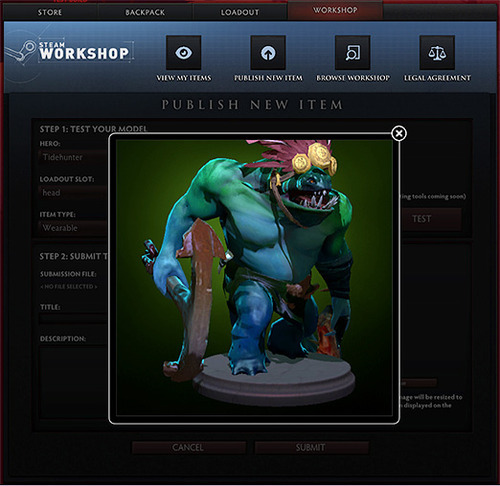
Featured Blog | This community-written post highlights the best of what the game industry has to offer. Read more like it on the Game Developer Blogs or learn how to Submit Your Own Blog Post
Steam Dev Days: Microtransactions According to Valve
Valve gave tips and strategies for in-game real-money economies at Steam Dev Days. Here is a breakdown and analysis on them.

In-app purchases have now been around long enough as a monetization strategy that they're now an established practice in the game industry—although the industry seems to have a love-hate relationship with them. We knew when we started building World Zombination that we wanted the game to be an MMO and that would mean we’d have to consider free-to-play as our strategy. It turns out that opting for this model puts us in good company: Valve (among other great companies) has fully embraced it. The team at Proletariat—and the industry at-large—can learn a lot from how Valve approaches free-to-play.
I attended the Steam Developer Days in January, at which Valve spent considerable time discussing three topics: the Steam Box, virtual reality, and microtransactions. Much has been said in the industry and media about the first two topics, but microtransactions haven’t been as thoroughly examined. Microtransactions are especially important to us, though, considering we’re making a free-to-play game.
At this conference, Kyle Davis spoke about in-game economies in Team Fortress 2 and DOTA 2, focusing on the five rules Valve follows to build new microtransaction-driven mechanics and economies. This post will cover each of these topics and discuss some of the ways we plan to apply them to World Zombination.
1. Microtransactions should provide persistent customer value
This is the keystone to an opt-in economy and it weaves itself into the other topics below. The idea here is that when a user pays for something, that object has lasting value beyond just the relief of a temporary pinch. Many free-to-play games capitalize on these mechanics, and they usually focus on consumables used for convenience. In the simplest terms, this is the old arcade strategy of putting in another quarter to keep playing, with no lasting value to the player since the state of the game will be erased when the game ends.

When in comes to in-app purchases, we want the player to remember—and feel good about—their purchase in a few weeks. Many games do this well; League of Legends is a great example. Once a Champion is purchased, the player owns it forever. In general, most consumables break this rule, but the outcome of using that item can have lasting value as well, which leads into the next idea.
2. Microtransactions should provide positive externalities
“Positive externalities” simply means that if one player purchases something in the game, it should make the game better for every player, not worse, which is a wonderfully elegant way to consider every in-game transaction. For this reason, we won’t use common pay-to-win mechanics in World Zombination. This idea is where consumables can really shine. The example given at Steam Dev Days was a booster in DOTA 2 that grants the player who purchases it an excellent buff and then every other player in a game who is playing with that user also receives a buff, but a smaller one.

I absolutely love this rule, and it’s something we have been focusing on with World Zombination. Our crystalizing example comes from one of our founders who paid for his WoW guild’s voice chat server and webhosting. He paid for it because it helped everyone in his guild and didn’t feel selfish. Making a purchase for your guild/team/friends is a very powerful idea that every game should consider.
3. Everything should be tradable
This is a difficult rule to follow in many cases because certain mechanics and games simply aren’t set up to allow this, but a good argument can be made for the value of trading. When everything in the economy is tradable, it provides obvious long-term value benefits because even if a player changes their play style or rolls a new character, they can trade off their hard earned stuff. In the case of Valve, this is done even across multiple games, so if a player is done playing DOTA 2, they can trade their stuff for items in another game.

Kyle used the example of crates and keys in Team Fortress 2. Crates contain a random drop of items but can only be opened using keys that are purchased for real money. Some players will never spend real money, so they’ll have crates sitting in their inventory forever. Though the majority of players have never opened a crate, most players possess an item that came from a crate. This shows how important trading is to the player base in a way that most microtransactions are not.
4. Value should distribute randomly
This may seem obvious, but when used properly, it can really engage a community around an economy and stretch content much further. When applying this rule, it’s important to consider how this impacts issues like trading. If everything in the economy is tradable, it’s much easier to have random drops because players can still get value out of them. Without trading, this becomes more constrained and means that content is more segmented depending on the structure of the value presented to players.
5. Players should be able to contribute content
This rule, just like the tradability rule above, is somewhat limited by the type of game. Valve does a great job of creating tools to let players add value to games and then creating economies where they can be compensated with real money for their efforts. This creates a new level of structure on top of the base economy where players become brand names and content is created in a naturally expanding way based on supply and demand.

Current trends indicate that players are becoming more interested in content creation, with some games based solely around it. If it’s possible for us to open this channel, it could be a way to further encourage players to invest in World Zombination and deliver content in a more scalable way than our development team could likely achieve.
Now What?
Valve has managed to create thriving free-to-play games and stable microtransaction economies over many years of testing and development. A set of rules like this doesn’t come easy, and while I don’t think they can be applied to every game, the rules are helpful when making decisions about microtransactions that will keep the game fun.
When we think about World Zombination, the first two rules are the ones that really hit home. Our goal is to make sure that every time a player pays, they are getting something of value, even if they only purchase a consumable item, and that players around them also benefit in some way. We hope to create this value in the way we implement our event systems and our mechanics around guilds and teams. Free-to-play games can be good for both developers and players and, as the model matures, we will see new strategies and directions taken by different games. The bottom line is to provide value to players and make them feel great about every single purchase.
Read more about:
Featured BlogsAbout the Author(s)
You May Also Like







.jpeg?width=700&auto=webp&quality=80&disable=upscale)








